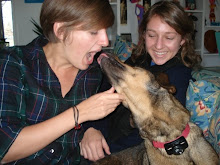You know that scene in "Annie Hall," the one where Alvy's stuck in line for the movies in front of a man who's "screaming his opinions in my ear"? "It's maddening," Alvy says to Annie before turning to the man: "Aren't you ashamed to pontificate like that?" Apparently no, Alvy realizes. The man is not ashamed to pontificate like that.

And I don't think many people in New York are, either.
I recently watched "Black Narcissus," the 1947 Academy Award-winning film about nuns who go crazy in the Himalayas (it's similar to Three Cups of Tea, but instead of a burly, go-getter like Greg Mortenson trying to build a school among jagged mountain peaks, it's a gaggle of sexually repressed ladies with severe emotional problems). Anyway, Jack Cardiff, who won the Oscar for cinematography for the film, said he derived inspiration from the works of 17th Century Dutch painter Johannes Vermeer, whose work just happened to be on display at the Metropolitan Museum of Art this week... just 40 minutes away from my home in Brooklyn. So, after watching the film, I went to see the paintings.
Indeed, the similarities were apparent. Both figures—Cardiff's celluloid nuns and Vermeer's oil-based milkmaids—are lit from the same angles with direct sunlight that streams in, usually through an open window within the frame. (Above: poster advertising the film "Black Narcissus"; Below: Vermeer's painting Young Woman with a Water Pitcher.) How exciting! I politely enjoyed the moment. I doubted anyone else within the hoard of curious onlookers at the Met was silently evaluating Vermeer's use of light, as imitated by Jack Cardiff, because they just so happened to see "Black Narcissus" the night before... it was certainly obvious that she wasn't.

She was a little woman, probably in her 50s, who stood at the front of the pack. She was next to an Asian kid—maybe a college student?—and it was unclear to me whether they were standing next to one another intentionally or as a stochatic byproduct of collective picture gazing, but he didn't seem to mind her.
"This was where the Renaissance started," she said while gazing at the 18" x 16" painting The Milkmaid. "These guys were masters, I mean they really were masters."
The Asian kid didn't really say much, although he briefly pointed out the fine detail of speckled light captured on the loaf of bread in the foreground. "Yes! I mean you can really feeeel the material," she said to the kid, as her shoulders came up to her ears, her eyes shrunk and the skin around them creased. She straightened up and looked back at the milkmaid. "It's really amaaazing."
It didn't help her case, as far as I was concerned, that she never smiled and carried an air of sophisticated indifference. Her salt-and-pepper hair jutted out from smack dab in the middle of her melon in rigid strands that stretched over her forehead, her ears and the nape of her neck like a star burst or an explosion that she knew was there but pretended not to notice. This rigid aura crept down to her jacket—black, military-style—which formed a canopy, like a bell, above her little legs (bound by tight black pants) and her feet (protected by clunky black clogs). It seemed appropriate that she should also be carrying a big, black messenger bag.
I eventually walked into the other room. Her voice was nauseating. (Really, it was the only one I could hear among the muffled whispers so politely supplied by everyone else in the room.)
"I mean, it's right next to this mundane thing, so it's very... impressionistic." Within seconds, the blabber mouth was behind me, staring at a picture on the opposite wall, her left arm bent with her fingers pressed against the small of her back, while her right arm floated off to the side, wire-rimmed glasses dangling from the delicate grip of her petite fingers, as if they didn't belong to her, as if she didn't care, as if the only thing that ever mattered was the art—the ART! "They didn't just INVENT something," she continued, now speaking to a woman who seemed more her age but remained just as silent as the Asian kid had been. "They used it to be extreme, not merely for an ACCENT." Good lord.
She moved on to another one, stared at it for a beat, then said: "I don't like it. He's got a deforrrmed... face. No. It's just too comical."
Of course, the scene from "Annie Hall" ends when Alvy and the man pontificating behind him bring up Marshal McLuhan, who suddenly emerges from behind a movie poster and proceeds to discredit everything the pontificating man had previously pontificated, and Alvy then turns to the camera and says: "Boy, if only life were like this!"
Unfortunately, it's not.
But that's why we have blogs.



